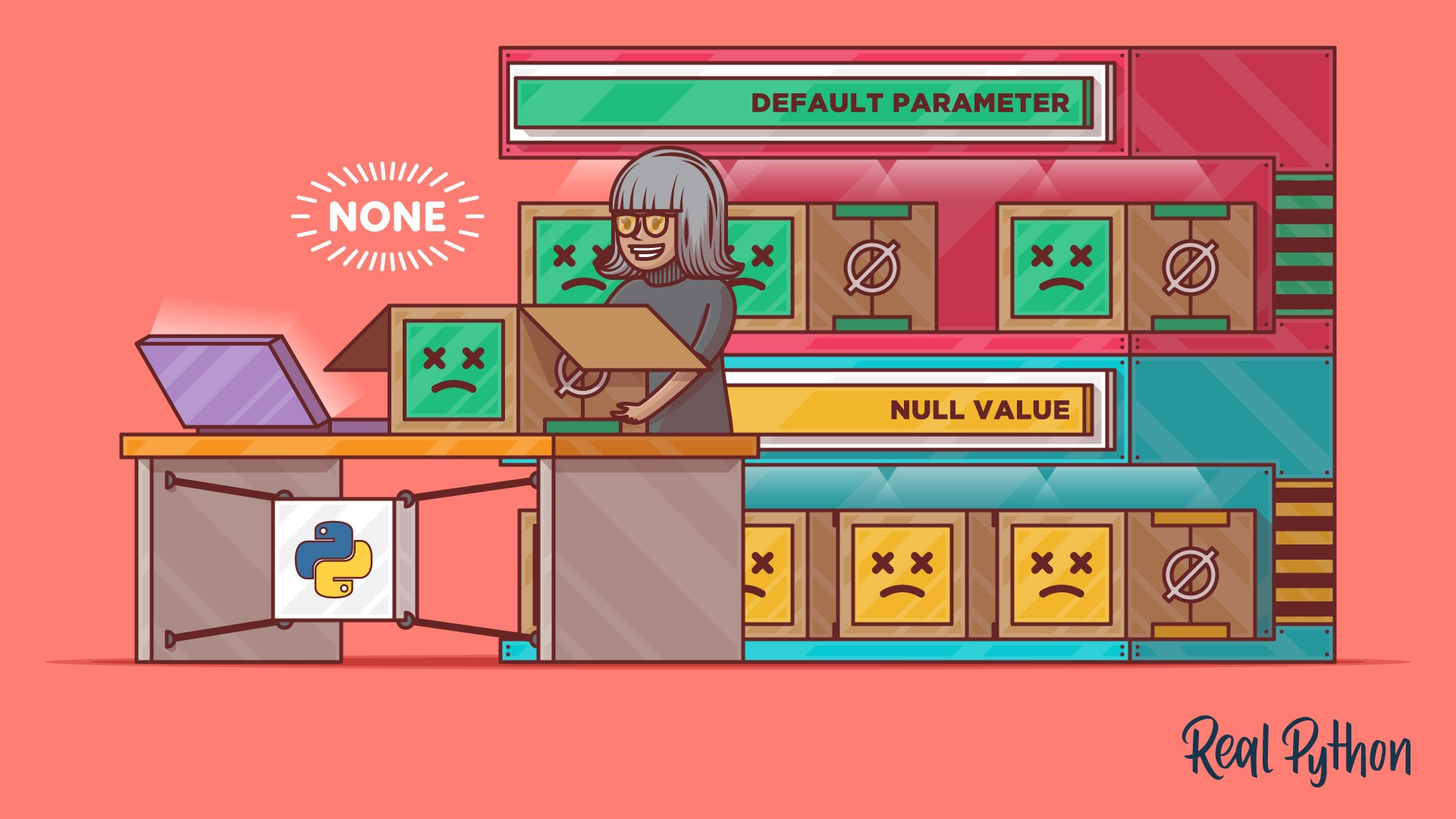Watch Now This tutorial has a related video course created by the Real Python team. Watch it together with the written tutorial to deepen your understanding: Python's None: Null in Python
If you have experience with other programming languages, like C or Java, then you’ve probably heard of the concept of null. Many languages use this to represent a pointer that doesn’t point to anything, to denote when a variable is empty, or to mark default parameters that you haven’t yet supplied. null is often defined to be 0 in those languages, but null in Python is different.
Python uses the keyword None to define null objects and variables. While None does serve some of the same purposes as null in other languages, it’s another beast entirely. As the null in Python, None is not defined to be 0 or any other value. In Python, None is an object and a first-class citizen!
In this tutorial, you’ll learn:
- What
Noneis and how to test for it - When and why to use
Noneas a default parameter - What
NoneandNoneTypemean in your traceback - How to use
Nonein type checking - How
nullin Python works under the hood
Free Bonus: Click here to get a Python Cheat Sheet and learn the basics of Python 3, like working with data types, dictionaries, lists, and Python functions.
Understanding Null in Python
None is the value a function returns when there is no return statement in the function:
>>> def has_no_return():
... pass
>>> has_no_return()
>>> print(has_no_return())
None
When you call has_no_return(), there’s no output for you to see. When you print a call to it, however, you’ll see the hidden None it returns.
In fact, None so frequently appears as a return value that the Python REPL won’t print None unless you explicitly tell it to:
>>> None
>>> print(None)
None
None by itself has no output, but printing it displays None to the console.
Interestingly, print() itself has no return value. If you try to print a call to print(), then you’ll get None:
>>> print(print("Hello, World!"))
Hello, World!
None
It may look strange, but print(print("...")) shows you the None that the inner print() returns.
None also often used as a signal for missing or default parameters. For instance, None appears twice in the docs for list.sort:
>>> help(list.sort)
Help on method_descriptor:
sort(...)
L.sort(key=None, reverse=False) -> None -- stable sort *IN PLACE*
Here, None is the default value for the key parameter as well as the type hint for the return value. The exact output of help can vary from platform to platform. You may get different output when you run this command in your interpreter, but it will be similar.
Using Python’s Null Object None
Often, you’ll use None as part of a comparison. One example is when you need to check and see if some result or parameter is None. Take the result you get from re.match. Did your regular expression match a given string? You’ll see one of two results:
- Return a
Matchobject: Your regular expression found a match. - Return a
Noneobject: Your regular expression did not find a match.
In the code block below, you’re testing if the pattern "Goodbye" matches a string:
>>> import re
>>> match = re.match(r"Goodbye", "Hello, World!")
>>> if match is None:
... print("It doesn't match.")
It doesn't match.
Here, you use is None to test if the pattern matches the string "Hello, World!". This code block demonstrates an important rule to keep in mind when you’re checking for None:
- Do use the identity operators
isandis not. - Do not use the equality operators
==and!=.
The equality operators can be fooled when you’re comparing user-defined objects that override them:
>>> class BrokenComparison:
... def __eq__(self, other):
... return True
>>> b = BrokenComparison()
>>> b == None # Equality operator
True
>>> b is None # Identity operator
False
Here, the equality operator == returns the wrong answer. The identity operator is, on the other hand, can’t be fooled because you can’t override it.
Note: For more info on how to compare with None, check out Do’s and Dont’s: Python Programming Recommendations.
None is falsy, which means not None is True. If all you want to know is whether a result is falsy, then a test like the following is sufficient:
>>> some_result = None
>>> if some_result:
... print("Got a result!")
... else:
... print("No result.")
...
No result.
The output doesn’t show you that some_result is exactly None, only that it’s falsy. If you must know whether or not you have a None object, then use is and is not.
The following objects are all falsy as well:
- Empty lists
- Empty dictionaries
- Empty sets
- Empty strings
0False
For more on comparisons, truthy values, and falsy values, you can read about how to use the Python or operator, how to use the Python and operator, and how to use the Python not operator.
Declaring Null Variables in Python
In some languages, variables come to life from a declaration. They don’t have to have an initial value assigned to them. In those languages, the initial default value for some types of variables might be null. In Python, however, variables come to life from assignment statements. Take a look at the following code block:
>>> print(bar)
Traceback (most recent call last):
File "<stdin>", line 1, in <module>
NameError: name 'bar' is not defined
>>> bar = None
>>> print(bar)
None
Here, you can see that a variable with the value None is different from an undefined variable. All variables in Python come into existence by assignment. A variable will only start life as null in Python if you assign None to it.
Using None as a Default Parameter
Very often, you’ll use None as the default value for an optional parameter. There’s a very good reason for using None here rather than a mutable type such as a list. Imagine a function like this:
def bad_function(new_elem, starter_list=[]):
starter_list.append(new_elem)
return starter_list
bad_function() contains a nasty surprise. It works fine when you call it with an existing list:
>>> my_list = ['a', 'b', 'c']
>>> bad_function('d', my_list)
['a', 'b', 'c', 'd']
Here, you add 'd' to the end of the list with no problems.
But if you call this function a couple times with no starter_list parameter, then you start to see incorrect behavior:
>>> bad_function('a')
['a']
>>> bad_function('b')
['a', 'b']
>>> bad_function('c')
['a', 'b', 'c']
The default value for starter_list evaluates only once at the time the function is defined, so the code reuses it every time you don’t pass an existing list.
The right way to build this function is to use None as the default value, then test for it and instantiate a new list as needed:
1>>> def good_function(new_elem, starter_list=None):
2... if starter_list is None:
3... starter_list = []
4... starter_list.append(new_elem)
5... return starter_list
6...
7>>> good_function('e', my_list)
8['a', 'b', 'c', 'd', 'e']
9>>> good_function('a')
10['a']
11>>> good_function('b')
12['b']
13>>> good_function('c')
14['c']
good_function() behaves as you want by making a new list with each call where you don’t pass an existing list. It works because your code will execute lines 2 and 3 every time it calls the function with the default parameter.
Using None as a Null Value in Python
What do you do when None is a valid input object? For instance, what if good_function() could either add an element to the list or not, and None was a valid element to add? In this case, you can define a class specifically for use as a default, while being distinct from None:
>>> class DontAppend: pass
...
>>> def good_function(new_elem=DontAppend, starter_list=None):
... if starter_list is None:
... starter_list = []
... if new_elem is not DontAppend:
... starter_list.append(new_elem)
... return starter_list
...
>>> good_function(starter_list=my_list)
['a', 'b', 'c', 'd', 'e']
>>> good_function(None, my_list)
['a', 'b', 'c', 'd', 'e', None]
Here, the class DontAppend serves as the signal not to append, so you don’t need None for that. That frees you to add None when you want.
You can use this technique when None is a possibility for return values, too. For instance, dict.get returns None by default if a key is not found in the dictionary. If None was a valid value in your dictionary, then you could call dict.get like this:
>>> class KeyNotFound: pass
...
>>> my_dict = {'a':3, 'b':None}
>>> for key in ['a', 'b', 'c']:
... value = my_dict.get(key, KeyNotFound)
... if value is not KeyNotFound:
... print(f"{key}->{value}")
...
a->3
b->None
Here you’ve defined a custom class KeyNotFound. Now, instead of returning None when a key isn’t in the dictionary, you can return KeyNotFound. That frees you to return None when that’s the actual value in the dictionary.
Deciphering None in Tracebacks
When NoneType appears in your traceback, it means that something you didn’t expect to be None actually was None, and you tried to use it in a way that you can’t use None. Almost always, it’s because you’re trying to call a method on it.
For instance, you called append() on my_list many times above, but if my_list somehow became anything other than a list, then append() would fail:
>>> my_list.append('f')
>>> my_list
['a', 'b', 'c', 'd', 'e', None, 'f']
>>> my_list = None
>>> my_list.append('g')
Traceback (most recent call last):
File "<stdin>", line 1, in <module>
AttributeError: 'NoneType' object has no attribute 'append'
Here, your code raises the very common AttributeError because the underlying object, my_list, is not a list anymore. You’ve set it to None, which doesn’t know how to append(), and so the code throws an exception.
When you see a traceback like this in your code, look for the attribute that raised the error first. Here, it’s append(). From there, you’ll see the object you tried to call it on. In this case, it’s my_list, as you can tell from the code just above the traceback. Finally, figure out how that object got to be None and take the necessary steps to fix your code.
Checking for Null in Python
There are two type checking cases where you’ll care about null in Python. The first case is when you’re returning None:
>>> def returns_None() -> None:
... pass
This case is similar to when you have no return statement at all, which returns None by default.
The second case is a bit more challenging. It’s where you’re taking or returning a value that might be None, but also might be some other (single) type. This case is like what you did with re.match above, which returned either a Match object or None.
The process is similar for parameters:
from typing import Any, List, Optional
def good_function(new_elem:Any, starter_list:Optional[List]=None) -> List:
pass
You modify good_function() from above and import Optional from typing to return an Optional[Match].
Taking a Look Under the Hood
In many other languages, null is just a synonym for 0, but null in Python is a full-blown object:
>>> type(None)
<class 'NoneType'>
This line shows that None is an object, and its type is NoneType.
None itself is built into the language as the null in Python:
>>> dir(__builtins__)
['ArithmeticError', ..., 'None', ..., 'zip']
Here, you can see None in the list of __builtins__ which is the dictionary the interpreter keeps for the builtins module.
None is a keyword, just like True and False. But because of this, you can’t reach None directly from __builtins__ as you could, for instance, ArithmeticError. However, you can get it with a getattr() trick:
>>> __builtins__.ArithmeticError
<class 'ArithmeticError'>
>>> __builtins__.None
File "<stdin>", line 1
__builtins__.None
^
SyntaxError: invalid syntax
>>> print(getattr(__builtins__, 'None'))
None
When you use getattr(), you can fetch the actual None from __builtins__, which you can’t do by simply asking for it with __builtins__.None.
Even though Python prints the word NoneType in many error messages, NoneType is not an identifier in Python. It’s not in builtins. You can only reach it with type(None).
None is a singleton. That is, the NoneType class only ever gives you the same single instance of None. There’s only one None in your Python program:
>>> my_None = type(None)() # Create a new instance
>>> print(my_None)
None
>>> my_None is None
True
Even though you try to create a new instance, you still get the existing None.
You can prove that None and my_None are the same object by using id():
>>> id(None)
4465912088
>>> id(my_None)
4465912088
Here, the fact that id outputs the same integer value for both None and my_None means they are, in fact, the same object.
Note: The actual value produced by id will vary across systems, and even between program executions. Under CPython, the most popular Python runtime, id() does its job by reporting the memory address of an object. Two objects that live at the same memory address are the same object.
If you try to assign to None, then you’ll get a SyntaxError:
>>> None = 5
Traceback (most recent call last):
File "<stdin>", line 1, in <module>
SyntaxError: can't assign to keyword
>>> None.age = 5
Traceback (most recent call last):
File "<stdin>", line 1, in <module>
AttributeError: 'NoneType' object has no attribute 'age'
>>> setattr(None, 'age', 5)
Traceback (most recent call last):
File "<stdin>", line 1, in <module>
AttributeError: 'NoneType' object has no attribute 'age'
>>> setattr(type(None), 'age', 5)
Traceback (most recent call last):
File "<stdin>", line 1, in <module>
TypeError: can't set attributes of built-in/extension type 'NoneType'
All the examples above show that you can’t modify None or NoneType. They are true constants.
You can’t subclass NoneType, either:
>>> class MyNoneType(type(None)):
... pass
...
Traceback (most recent call last):
File "<stdin>", line 1, in <module>
TypeError: type 'NoneType' is not an acceptable base type
This traceback shows that the interpreter won’t let you make a new class that inherits from type(None).
Conclusion
None is a powerful tool in the Python toolbox. Like True and False, None is an immutable keyword. As the null in Python, you use it to mark missing values and results, and even default parameters where it’s a much better choice than mutable types.
Now you can:
- Test for
Nonewithisandis not - Choose when
Noneis a valid value in your code - Use
Noneand its alternatives as default parameters - Decipher
NoneandNoneTypein your tracebacks - Use
NoneandOptionalin type hints
How do you use the null in Python? Leave a comment down in the comments section below!
Watch Now This tutorial has a related video course created by the Real Python team. Watch it together with the written tutorial to deepen your understanding: Python's None: Null in Python








